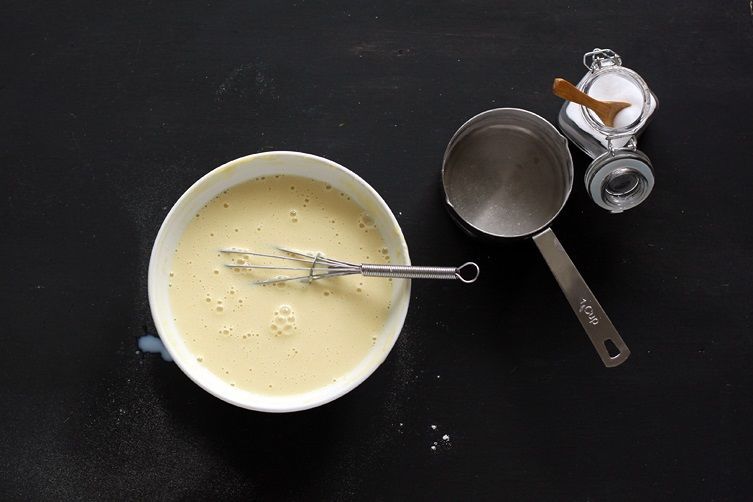Every week, a DIY expert spares us a trip to the grocery store and shows us how to make small batches of great foods at home.
Today: These Austrian crêpes from Ursula of Little Vienna are the perfect excuse to eat sweets for lunch.

Growing up in Austria means an inherent ability to make pancake batter, at least in my case. That is why Palatschinken are, by far, one of my favorite dishes. So what exactly are Palatschinken? Everyone knows French crêpes, but in Austria we have our own kind. The Austrian type is thicker than French crêpes, but thinner than American pancakes.
Traditionally, Palatschinken are filled with apricot jam, then rolled up and dusted with confectioners' sugar. You can find this variation on the menu of any traditional Austrian restaurant, known as a “Wirtshaus." They are also often served with a chocolate-walnut filling or sweetened quark (called “Topfen-Palatschinken”). Although untraditional, I also like them filled with bananas and Nutella.
More: If you go the Nutella route, try this homemade version.

One big plus of these is that they are much more forgiving than pancakes or French crêpes. You won't be able to recognize any imperfections, small or large, once they are rolled up and generously dusted with confectioners' sugar. They will all look like little masterpieces, no matter what you actually did.
This dish is traditionally served for lunch, as either a dessert or main course. In Austria, it’s common to eat sweet dishes like apricot dumplings, Kaiserschmarrn (shredded pancakes), baked rice pudding, or Palatschinken for a main course at lunch. This may be a weird habit to understand if you didn't grow up in Austria, but I have a feeling you'll embrace it once you have your first bite—it's the perfect excuse for a midday sweet treat.

The recipe is not only very easy and forgiving, but chances are you already have all of the ingredients on hand. Some cooks I know add vanilla sugar or 1 tablespoon of melted butter, but those additions are optional. After you have prepared this recipe a couple of times, you will easily be able to eyeball all the ingredients without measuring.
Palatschinken (Austrian Crêpes)
2 large eggs
1/8 teaspoon fine salt
1 cup (8 fluid ounces, 240 milliliters) milk, divided
1 cup (4 1/2 ounces, 130 grams) all-purpose flour
Butter, ghee, or neutral tasting oil, for coating the pan
Apricot jam, for the filling
Confectioners' sugar, for dusting

Whisk the eggs in a medium bowl until lightly beaten. Add salt and 1/3 cup (80 milliliters) of milk and beat until combined. Add the flour and whisk until you get a smooth batter. The batter should be so thick that you can barely whisk it—the thicker the batter, the fewer lumps you will have.
If the batter is too hard to stir, add a little milk, 1 tablespoon at a time, while whisking. After you've whisked the batter smooth, slowly add the remaining milk while continuing to whisk the mixture (This is my mother's secret for smooth Palatschinken).

Heat an 8-inch (or larger) nonstick pan over medium heat. Add 1/2 teaspoon of butter or ghee, or oil as needed, and spread it carefully with a spatula to coat the bottom of the pan evenly. This is important; otherwise, the butter will disturb the batter.
Pour 1/3 cup of the batter (for an 8-inch pan, more for larger pans) into the center of the pan and swirl the pan to spread the batter evenly. Once the bottom side is golden in color, flip it with a spatula and cook the other side for about 15 seconds. Invert it onto a plate so that the browned side is touching the plate and the pale side is face-up. This way, the nice looking side will be outside when you roll it.


Once the bottom side is golden in color, flip it with a spatula and cook the other side for about 15 seconds. Invert the pancake onto a plate—the browned side should touch the plate, with the pale side is face-up. This way, the nice looking side will be outside when you roll it.
Repeat with the remaining batter, adding 1/2 teaspoon of butter or oil for every Palatschinke (which is the singular form of Palatschinken). If the batter thickens over time and makes it harder to spread the batter in the pan, add some milk. You can keep the ready pancakes warm in the oven at a low temperature.

Spread the apricot jam on the Palatschinken and roll them from one side to the other.
Dust the Palatschinken with confectioners' sugar and serve with a fork and spoon—the spoon serves as a knife but the rounded edges make it easier to push each bite onto your fork. Enjoy!

See the entire recipe (and save and print it) here.
Photos by Ursula | LilVienna.com










See what other Food52 readers are saying.